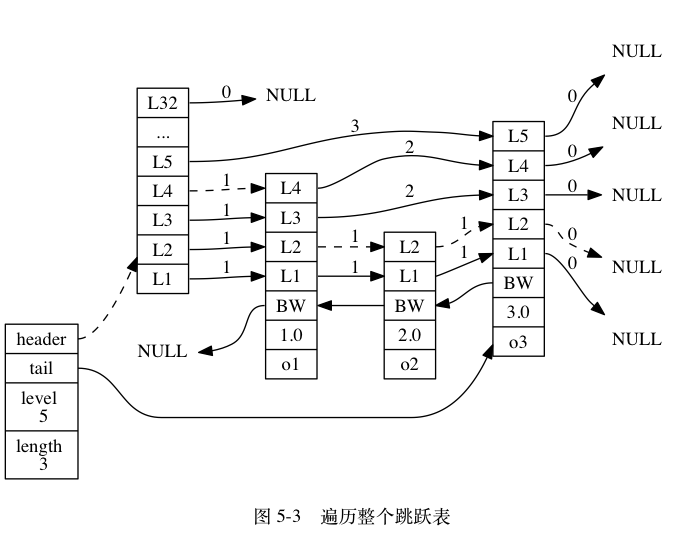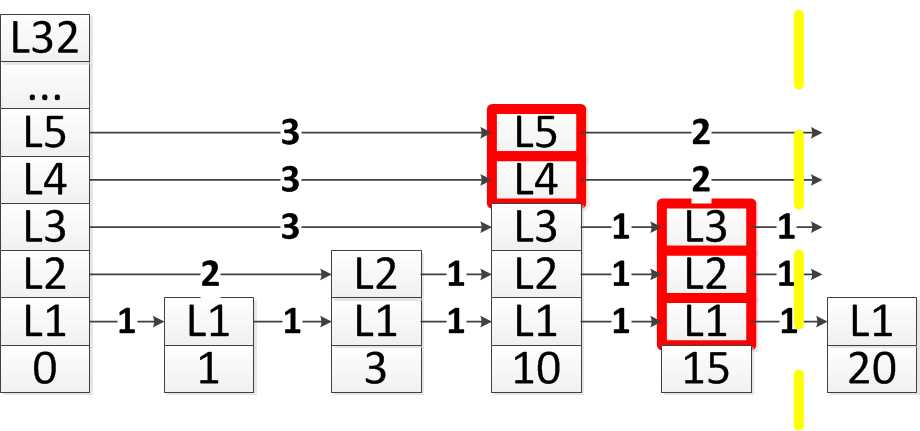本文主要介绍如下内容:
- 跳跃表介绍
- Redis中的跳跃表实现及特点
- Redis中的跳跃表源码难点分析
- Redis中的跳跃表源码部分节选
跳跃表介绍
跳跃表是一种随机化数据结构,基于并联的链表,其效率可以比拟平衡二叉树,查找、删除、插入等操作都可以在对数期望时间内完成,对比平衡树,跳跃表的实现要简单直观很多。
以下是一个跳跃表的例图(来自维基百科):
从图中可以看出跳跃表主要有以下几个部分构成:
1、 表头head:负责维护跳跃表的节点指针
2、 节点node:实际保存元素值,每个节点有一层或多层
3、 层level:保存着指向该层下一个节点的指针
4、 表尾tail:全部由null组成
跳跃表的遍历总是从高层开始,然后随着元素值范围的缩小,慢慢降低到低层。
Redis中的跳跃表实现及特点
Redis 的跳跃表由 redis.h/zskiplistNode 和 redis.h/zskiplist 两个结构体定义,具体实现在t_zset.c中。
跳跃表节点1
2
3
4
5
6
7
8
9
10/* ZSETs use a specialized version of Skiplists */
typedef struct zskiplistNode {
robj *obj;
double score;
struct zskiplistNode *backward;
struct zskiplistLevel {
struct zskiplistNode *forward;
unsigned int span;
} level[];
} zskiplistNode;
zskiplist 结构体1
2
3
4
5typedef struct zskiplist {
struct zskiplistNode *header, *tail;
unsigned long length;
int level;
} zskiplist;
header 和 tail 指针分别指向跳跃表的表头和表尾节点, 通过这两个指针, 程序定位表头节点和表尾节点的复杂度为 O(1) 。
通过使用 length 属性来记录节点的数量, 程序可以在 O(1) 复杂度内返回跳跃表的长度。
level 属性则用于在 O(1) 复杂度内获取跳跃表中层高最大的那个节点的层数量, 注意表头节点的层高并不计算在内。
特点
- 跳跃表是有序集合的底层实现之一
- Redis的跳跃表实现由 zskiplist 和 zskiplistNode两个结构组成,其中 zskiplist 用于保存跳跃表信息(比如表头节点、表尾节点、长度), 而zskiplistNode则用于表示跳跃表节点
- 每个跳跃表节点的层高都是 1 至 32 之间的随机数。
- 在同一个跳跃表中, 多个节点可以包含相同的分值, 但每个节点的成员对象必须是唯一的。
- 跳跃表中的节点按照分值大小进行排序, 当分值相同时, 节点按照成员对象的大小进行排序。
–
与通常描述的跳跃表的区别
Redis的跳跃表实现跟WilliamPugh在”Skip Lists: A Probabilistic Alternative to Balanced Trees”中描述的跳跃表算法类似,只是有如下不同:
- 允许重复分数
- 排序不止根据分数,还可能根据成员对象(当分数相同时)
- 每个跳表节点中有backward指向前驱节点,从而可以方便的从表尾向表头遍历,用于ZREVRANGE命令的实现。
Redis中的跳跃表源码难点分析
随机算法函数
zslRandomLevel函数为我们要建的新跳表返回一个随机的层数,该数在1~32之间,且越大的数出现的概率越小。1
2
3
4
5
6
7
8
9
10/* Returns a random level for the new skiplist node we are going to create.
* The return value of this function is between 1 and ZSKIPLIST_MAXLEVEL
* (both inclusive), with a powerlaw-alike distribution where higher
* levels are less likely to be returned. */
int zslRandomLevel(void) {
int level = 1;
while ((random()&0xFFFF) < (ZSKIPLIST_P * 0xFFFF))
level += 1;
return (level<ZSKIPLIST_MAXLEVEL) ? level : ZSKIPLIST_MAXLEVEL;
}
这里的ZSKIPLIST_P是0.25。上述代码中,level初始化为1,然后,如果持续满足条件:(random()&0xFFFF)< (ZSKIPLIST_P 0xFFFF)的话,则level+=1。最终调整level的值,使其小于ZSKIPLIST_MAXLEVEL。 理解该算法的核心,就是要理解满足条件:(random()&0xFFFF) < (ZSKIPLIST_P 0xFFFF)的概率是多少?
random()&0xFFFF形成的数,均匀分布在区间[0,0xFFFF]上,那么这个数小于(ZSKIPLIST_P 0xFFFF)的概率是多少呢?自然就是ZSKIPLIST_P,也就是0.25了。
因此,最终返回level为1的概率是1-0.25=0.75,返回level为2的概率为0.250.75,返回level为3的概率为0.250.250.75……因此,如果返回level为k的概率为x,则返回level为k+1的概率为0.25x,换句话说,如果k层的结点数是x,那么k+1层就是0.25x了。这就是所谓的幂次定律(powerlaw),越大的数出现的概率越小。
1 | typedef struct zskiplistNode { |
1 | zskiplist *zslCreate(void) { |
插入节点
1 | zskiplistNode *zslInsert(zskiplist *zsl, double score, robj *obj) { |
关于插入节点这个函数的实现,我们需要明白几点,在知道zskiplistNode和zskiplist数据结构的基础上,把以下几点弄明白了,整个函数就好理解了。
- 辅助数组update的作用是什么
- 数组rank的作用是什么
- 哪些层需要插入该节点
- 结构体zskiplistNode中span的意义是什么
第1个问题:首先我们要插入一个节点,与链表类似,需要找到合适位置插入,而辅助数组update就用来存放待插入节点在每一层应该插入的位置的,即代码开头这一段:1
2
3
4
5
6
7
8
9
10
11
12
13x = zsl->header;
for (i = zsl->level-1; i >= 0; i--) {
/* store rank that is crossed to reach the insert position */
rank[i] = i == (zsl->level-1) ? 0 : rank[i+1];
while (x->level[i].forward &&
(x->level[i].forward->score < score ||
(x->level[i].forward->score == score &&
compareStringObjects(x->level[i].forward->obj,obj) < 0))) {
rank[i] += x->level[i].span;
x = x->level[i].forward;
}
update[i] = x;
}
第2个问题,数组rank用来存放的是每层合适的待插入位置的排名,比如在下图的跳跃表中,假设现在要插入的结点分数为17,黄色虚线所标注的,就是插入新结点的位置。下面标注红色的,就是在每层找到的插入结点的前驱结点,记录在update[i]中,而rank[i]记录了update[i]在跳跃表中的排名,因此,rank[4] = 3, rank[3] = 3, rank[2] = 4, rank[1] = 4, rank[0] = 4
第3个问题哪些层需要插入这个节点,这个问题在Redis中是采用了前面说的随机算法,利用随机算法得出一个在1~32之间的level值,第0层到第level-1层都需要插入该节点:1
2
3
4
5
6
7
8
9level = zslRandomLevel();
if (level > zsl->level) {
for (i = zsl->level; i < level; i++) {
rank[i] = 0;
update[i] = zsl->header;
update[i]->level[i].span = zsl->length;
}
zsl->level = level;
}
第4个问题:zskiplistNode中span表示跨度,用于记录当前节点的forward指针指向的节点和当前节点的距离(如果指向 NULL,那么前进指针的跨度都为0,因为它们没有连向任何节点)。此外,由于排名rank是由前面各span累积起来的,比如上面给的图中的值为10的节点的排名就是3,所以我们在计算当前节点的span的时候,可以用后继节点排名减去当前节点节点排名,下面这段代码就用了这个逻辑:1
2
3
4
5
6
7
8
9x = zslCreateNode(level,score,obj);
for (i = 0; i < level; i++) {
x->level[i].forward = update[i]->level[i].forward;
update[i]->level[i].forward = x;
/* update span covered by update[i] as x is inserted here */
x->level[i].span = update[i]->level[i].span - (rank[0] - rank[i]);
update[i]->level[i].span = (rank[0] - rank[i]) + 1;
}
最后这段代码就好理解了,只需要看结构图就明白了1
2
3
4
5
6x->backward = (update[0] == zsl->header) ? NULL : update[0];
if (x->level[0].forward)
x->level[0].forward->backward = x;
else
zsl->tail = x;
zsl->length++;
结构图:
即如果update[0] == zsl->header,那么根据图,它的backward就应该为NULL;
如果x->level[0].forward为NULL,那表明该节点为尾节点,所以zsl->tail = x。
Redis中的跳跃表源码部分节选
删除跳表中匹配score和obj的节点
理解了上面的插入节点,这个部分是很好看懂的,请看源码:1
2
3
4
5
6
7
8
9
10
11
12
13
14
15
16
17
18
19
20
21
22
23
24
25
26
27
28
29
30
31
32
33
34
35
36
37
38
39
40
41
42
43
44
45/* Internal function used by zslDelete, zslDeleteByScore and zslDeleteByRank */
void zslDeleteNode(zskiplist *zsl, zskiplistNode *x, zskiplistNode **update) {
int i;
for (i = 0; i < zsl->level; i++) {
if (update[i]->level[i].forward == x) {
update[i]->level[i].span += x->level[i].span - 1;
update[i]->level[i].forward = x->level[i].forward;
} else {
update[i]->level[i].span -= 1;
}
}
if (x->level[0].forward) {
x->level[0].forward->backward = x->backward;
} else {
zsl->tail = x->backward;
}
while(zsl->level > 1 && zsl->header->level[zsl->level-1].forward == NULL)
zsl->level--;
zsl->length--;
}
/* Delete an element with matching score/object from the skiplist. */
int zslDelete(zskiplist *zsl, double score, robj *obj) {
zskiplistNode *update[ZSKIPLIST_MAXLEVEL], *x;
int i;
x = zsl->header;
for (i = zsl->level-1; i >= 0; i--) {
while (x->level[i].forward &&
(x->level[i].forward->score < score ||
(x->level[i].forward->score == score &&
compareStringObjects(x->level[i].forward->obj,obj) < 0)))
x = x->level[i].forward;
update[i] = x;
}
/* We may have multiple elements with the same score, what we need
* is to find the element with both the right score and object. */
x = x->level[0].forward;
if (x && score == x->score && equalStringObjects(x->obj,obj)) {
zslDeleteNode(zsl, x, update);
zslFreeNode(x);
return 1;
}
return 0; /* not found */
}
获取某一score和成员对象o对应的节点的排名1
2
3
4
5
6
7
8
9
10
11
12
13
14
15
16
17
18
19
20
21
22
23
24
25
26/* Find the rank for an element by both score and key.
* Returns 0 when the element cannot be found, rank otherwise.
* Note that the rank is 1-based due to the span of zsl->header to the
* first element. */
unsigned long zslGetRank(zskiplist *zsl, double score, robj *o) {
zskiplistNode *x;
unsigned long rank = 0;
int i;
x = zsl->header;
for (i = zsl->level-1; i >= 0; i--) {
while (x->level[i].forward &&
(x->level[i].forward->score < score ||
(x->level[i].forward->score == score &&
compareStringObjects(x->level[i].forward->obj,o) <= 0))) {
rank += x->level[i].span;
x = x->level[i].forward;
}
/* x might be equal to zsl->header, so test if obj is non-NULL */
if (x->obj && equalStringObjects(x->obj,o)) {
return rank;
}
}
return 0;
}
需要注意的是在同一个跳跃表中, 各个节点保存的成员对象必须是唯一的, 但是多个节点保存的分值却可以是相同的,否则上面的实现是有问题的,如果没有这一限制,如果在该跳表中只有一个大于score,且成员对象也为o的节点,那么此时会返回rank,而这个时候其实是应该返回0,即表示没有找到相应的节点。由于已经限定没有重复o,所以上述实现正确。
根据排名找对应的节点:1
2
3
4
5
6
7
8
9
10
11
12
13
14
15
16
17
18
19
20/* Finds an element by its rank. The rank argument needs to be 1-based. */
zskiplistNode* zslGetElementByRank(zskiplist *zsl, unsigned long rank) {
zskiplistNode *x;
unsigned long traversed = 0;
int i;
x = zsl->header;
for (i = zsl->level-1; i >= 0; i--) {
while (x->level[i].forward && (traversed + x->level[i].span) <= rank)
{
traversed += x->level[i].span;
x = x->level[i].forward;
}
if (traversed == rank) {
return x;
}
}
return NULL;
}
结构体zrangespec
该结构体给出一个score的范围min~max,minex和maxex是用来表示这个范围区间开闭的,为0表示包括,为1表示不包括。如果要表示[10, 15],那么1
2
3zrangespec.min = 10;
zrangespec.max = 15;
zrangespec.minex = zrangespec.maxex = 0;1
2
3
4
5/* Struct to hold a inclusive/exclusive range spec by score comparison. */
typedef struct {
double min, max;
int minex, maxex; /* are min or max exclusive? */
} zrangespec;
给定一个分值范围, 返回跳跃表中第一个符合这个范围的节点:1
2
3
4
5
6
7
8
9
10
11
12
13
14
15
16
17
18
19
20
21
22
23
24
25
26
27
28
29
30
31
32
33
34
35
36
37
38
39
40
41
42/* Returns if there is a part of the zset is in range. */
int zslIsInRange(zskiplist *zsl, zrangespec *range) {
zskiplistNode *x;
/* Test for ranges that will always be empty. */
if (range->min > range->max ||
(range->min == range->max && (range->minex || range->maxex)))
return 0;
x = zsl->tail;
if (x == NULL || !zslValueGteMin(x->score,range))
return 0;
x = zsl->header->level[0].forward;
if (x == NULL || !zslValueLteMax(x->score,range))
return 0;
return 1;
}
/* Find the first node that is contained in the specified range.
* Returns NULL when no element is contained in the range. */
zskiplistNode *zslFirstInRange(zskiplist *zsl, zrangespec *range) {
zskiplistNode *x;
int i;
/* If everything is out of range, return early. */
if (!zslIsInRange(zsl,range)) return NULL;
x = zsl->header;
for (i = zsl->level-1; i >= 0; i--) {
/* Go forward while *OUT* of range. */
while (x->level[i].forward &&
!zslValueGteMin(x->level[i].forward->score,range))
x = x->level[i].forward;
}
/* This is an inner range, so the next node cannot be NULL. */
x = x->level[0].forward;
redisAssert(x != NULL);
/* Check if score <= max. */
if (!zslValueLteMax(x->score,range)) return NULL;
return x;
}
给定一个分值范围, 返回跳跃表中最后一个符合这个范围的节点:1
2
3
4
5
6
7
8
9
10
11
12
13
14
15
16
17
18
19
20
21
22
23
24
25/* Find the last node that is contained in the specified range.
* Returns NULL when no element is contained in the range. */
zskiplistNode *zslLastInRange(zskiplist *zsl, zrangespec *range) {
zskiplistNode *x;
int i;
/* If everything is out of range, return early. */
if (!zslIsInRange(zsl,range)) return NULL;
x = zsl->header;
for (i = zsl->level-1; i >= 0; i--) {
/* Go forward while *IN* range. */
while (x->level[i].forward &&
zslValueLteMax(x->level[i].forward->score,range))
x = x->level[i].forward;
}
/* This is an inner range, so this node cannot be NULL. */
redisAssert(x != NULL);
/* Check if score >= min. */
if (!zslValueGteMin(x->score,range)) return NULL;
return x;
}
给定一个分值范围, 删除跳跃表中所有在这个范围之内的节点1
2
3
4
5
6
7
8
9
10
11
12
13
14
15
16
17
18
19
20
21
22
23
24
25
26
27
28
29
30
31
32
33
34
35/* Delete all the elements with score between min and max from the skiplist.
* Min and max are inclusive, so a score >= min || score <= max is deleted.
* Note that this function takes the reference to the hash table view of the
* sorted set, in order to remove the elements from the hash table too. */
unsigned long zslDeleteRangeByScore(zskiplist *zsl, zrangespec *range, dict *dict) {
zskiplistNode *update[ZSKIPLIST_MAXLEVEL], *x;
unsigned long removed = 0;
int i;
x = zsl->header;
for (i = zsl->level-1; i >= 0; i--) {
while (x->level[i].forward && (range->minex ?
x->level[i].forward->score <= range->min :
x->level[i].forward->score < range->min))
x = x->level[i].forward;
update[i] = x;
}
/* Current node is the last with score < or <= min. */
x = x->level[0].forward;
/* Delete nodes while in range. */
while (x &&
(range->maxex ? x->score < range->max : x->score <= range->max))
{
zskiplistNode *next = x->level[0].forward;
zslDeleteNode(zsl,x,update);
dictDelete(dict,x->obj);
zslFreeNode(x);
removed++;
x = next;
}
return removed;
}
需要注意的是minex为1表示包括左边是开区间,为0表示闭区间,maxex为1表示右边为开区间,为0表示闭区间。
删除排名在[start, end]之间的所有节点,包含start和end1
2
3
4
5
6
7
8
9
10
11
12
13
14
15
16
17
18
19
20
21
22
23
24
25
26
27
28/* Delete all the elements with rank between start and end from the skiplist.
* Start and end are inclusive. Note that start and end need to be 1-based */
unsigned long zslDeleteRangeByRank(zskiplist *zsl, unsigned int start, unsigned int end, dict *dict) {
zskiplistNode *update[ZSKIPLIST_MAXLEVEL], *x;
unsigned long traversed = 0, removed = 0;
int i;
x = zsl->header;
for (i = zsl->level-1; i >= 0; i--) {
while (x->level[i].forward && (traversed + x->level[i].span) < start) {
traversed += x->level[i].span;
x = x->level[i].forward;
}
update[i] = x;
}
traversed++;
x = x->level[0].forward;
while (x && traversed <= end) {
zskiplistNode *next = x->level[0].forward;
zslDeleteNode(zsl,x,update);
dictDelete(dict,x->obj);
zslFreeNode(x);
removed++;
traversed++;
x = next;
}
return removed;
参考资料
Redis设计与实现
Redis源码3.0.6
漫画算法:什么是跳跃表?
浅析SkipList跳跃表原理及代码实现
Redis源码解析:05跳跃表
__typeof__() 、 __typeof() 、 typeof()的区别



